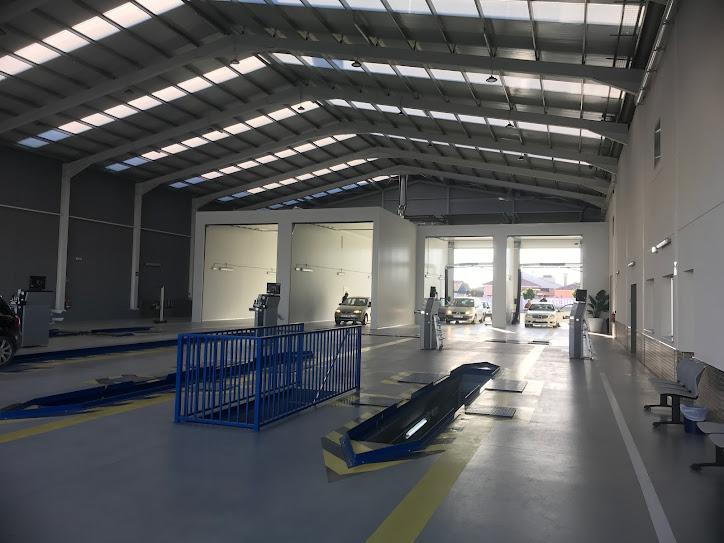Once you buy a new vehicle in Spain, there will come a time when it has to undergo a mandatory safety inspection, the ITV test, or Inspección Técnica de Vehículos, with a positive result meaning that you will acquire a sticker for your windscreen, and a report of the test, which must subsequently be carried in the vehicle along with your other documents.
How often is the ITV test carried out?
Cars: 4 years after their first registration date, and every 2 years thereafter. Cars over 10 years old must be tested for roadworthiness every year.
Motorbikes and quadricycles: 4 years after their first registration date, and every 2 years thereafter.
Buses/coaches: 5 years after their first registration date and every 6 months thereafter.
Mopeds: 3 years after their first registration date and every 2 years thereafter.
There are certain circumstances where the test must be carried out outside this established schedule.

The first thing to do is to choose an ITV inspection centre. You are free to choose any official authorised test centre anywhere in the country, irrespective of where you live. Certain elements of the test differ in some areas, but the standard is the same everywhere, and so the ITV inspection is valid nationally.
Once you have chosen your test centre, you can book an appointment online in many, which does make the procedure easier, and you must remember to take your documents with you when you attend the centre.
The test itself is a simple procedure that ensures that the primary safety features on the vehicle are working. You won´t be judged on your taste in music, or if you have flowery seat covers, it is just about the safety elements.
That said, there are a few things that you can check before you go for your ITV inspection, and make it even easier, after all the aim is to come away with a successful inspection so that we can continue driving.
When you subject your vehicle to a test, there are three possible outcomes. Favourable, in which the vehicle has passed with no problems, unfavourable, in which case the vehicle has failed. In the event of an unfavourable report, the vehicle cannot be driven. The same applies for an expired ITV test in the future, if your ITV expires then the vehicle is not permitted on the public roads, you must arrange to truck, a grua, to take the vehicle on its back. In the UK it is possible to book an appointment for your MOT and you are permitted to drive the vehicle to that appointment, irrespective of the status of the car. In Spain there is no such luxury. If a vehicle does not have a valid ITV certificate, it cannot be driven on the roads.
The third possible status after the test will be that the inspector has noticed some minor faults. In this case, the vehicle will not be failed, but these faults will be detailed on the ITV report you will be given at the end of the test. You then have a maximum of two months in which to have these faults repaired. In this case you are permitted to drive the vehicle, but only to get the repairs carried out and then return to the test centre once complete.
However, today we are talking about things that can be checked before we go for the examination, and therefore, hopefully, pass with a favourable result.
First, take a slow and detailed walk around the vehicle. Look closely at the body work. You need to pay particular attention to deformations, misshapes, dents and the likes, but particularly for any sharp edges. Vehicle designs are always smooth and flowing, partly for aerodynamic reasons, but also, in this case, because sharp edges can cause considerably more damage in the event of a collision. Imagine if the wing of the car was damaged and has a serrated edge where the previous collision took place. If that part of the car impacted with a pedestrian or cyclist, for example, the damage would be catastrophic.
As you go around the vehicle make sure that the rear-view mirrors on the outside are in good condition, not broken or speckled, and that visibility is good. You will have to do the same for the interior mirror too. All mirrors must be correctly fixed in their original housings and firm.
Whilst we are walking around the vehicle, also check the tyres. Make sure that there is sufficient tread around each tyre, that the wear (if any) is equal, and that there are no deformations. You need to carry out both a visible check and also get your hands dirty by feeling your way around each tyre, including on the side that you can´t see, and don´t forget to check the spare wheel if your vehicle has one.
It is also a good idea to check each of the tyres conforms to the requirements printed on the vehicle´s documentation.
As we are moving to the interior of the vehicle, check all the doors. Make sure that they all open easily, that they close, and that they remain securely closed.
Next, we need to check the seat belts. Make sure that all seat belts move freely when pulled from their roll, and then give each of them a jolt to make sure that they lock when they are supposed to. You also need to make sure that free movement returns after the jolt. Ensure that the seat belts all click into their locking attachment, and unclip easily when pressed. They must not come away from the locking mechanism unless the button is pressed. To make things easier during the inspection, it is a good idea to leave any unused seat belts buckled fully, as that speeds the process up slightly for the inspectors.
From inside the vehicle we need to check that the horn works, although be careful when you test this so as not to alarm anybody. Don´t forget that the interior rear view mirror also needs checking that it is clear and firmly fixed.
Whilst checking the horn, we can also check the lights, perhaps getting someone to help you at this point, as all lights need to be tested, so that means the headlights, dipped and full beam, brake lights, indicators, reversing lights, and fog lights, making sure they all work correctly. Pay close attention to the headlights during this check, making sure that the glass is clear. In Spain we suffer from a “frosting” effect as the strong sun discolours the coating on the headlights. This frosting can result in a failed examination, so make sure they are clear and get them treated before the test if needed.
Whilst also sat in the vehicle, check the dashboard, in particular looking for any obvious problems such as engine warning lights, or other warnings, as these too can prevent the vehicle from passing.
Finally, windscreen wipers must be in good condition, and the windscreen washer reservoir topped up with liquid for cleaning the windscreen.
If you carry out these simple checks, there is a higher chance of you getting through the test without any problems, but we must keep in mind that some faults cannot be seen by these basic checks, but the examiners are highly trained and qualified in ensuring that the safety features are all working, and so if anything is identified as being wrong, not only is it important to get it fixed, it is an important way of having faults which could lead to further problems identified.
Finally, when it comes to the next test, you can have this carried out up to a month before the expiry and the dates will be added to the end of the next expiration period. You must however successfully pass the test before the expiry date, as you are not permitted to drive the vehicle without a valid ITV in place, and that includes driving it to the test centre. If the ITV expires, the vehicle is not allowed to be driven under any circumstances.
The post How to prepare for the ITV test first appeared on N332.es – Driving In Spain.





